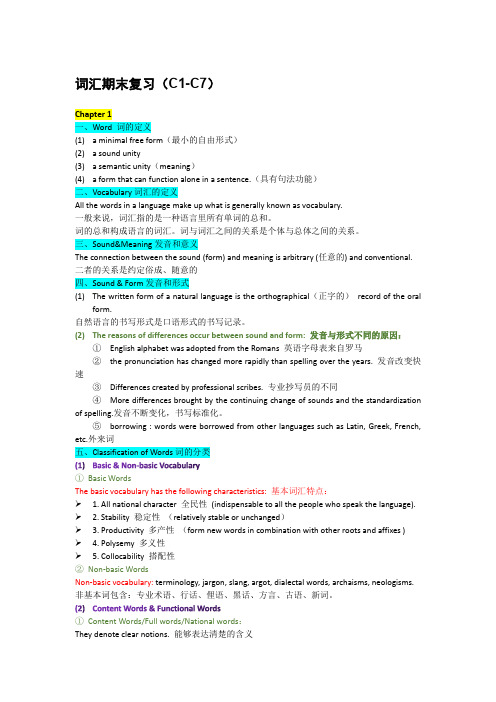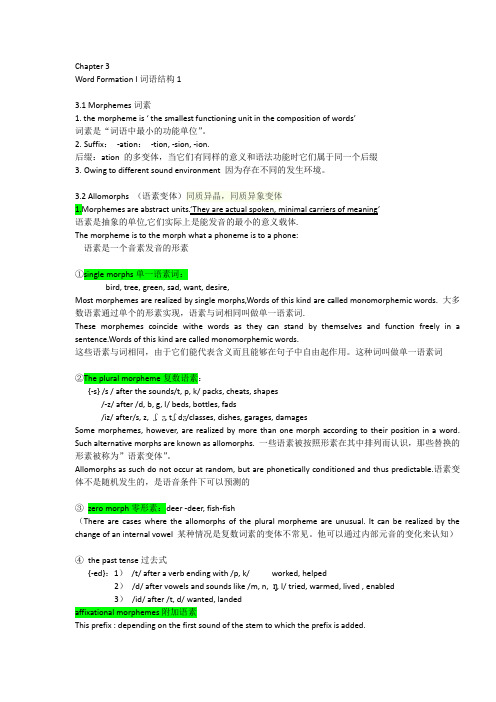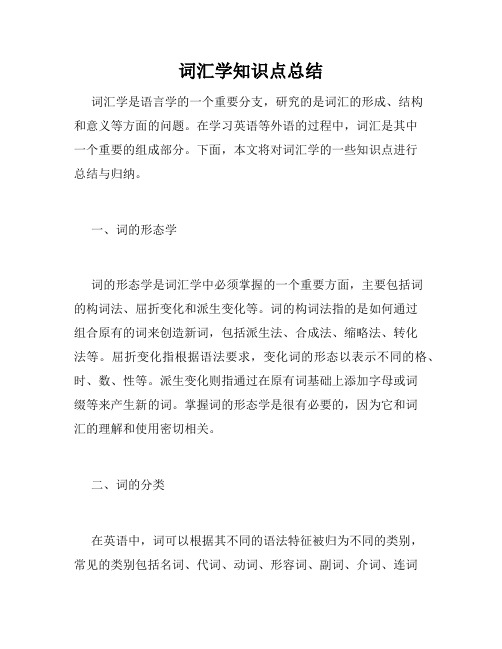英语词汇学总结(细致)
英语词汇学知识点整理

词汇期末复习(C1-C7)Chapter 1一、Word 词的定义(1) a minimal free form(最小的自由形式)(2) a sound unity(3) a semantic unity(meaning)(4) a form that can function alone in a sentence.(具有句法功能)二、Vocabulary词汇的定义All the words in a language make up what is generally known as vocabulary.一般来说,词汇指的是一种语言里所有单词的总和。
词的总和构成语言的词汇。
词与词汇之间的关系是个体与总体之间的关系。
三、Sound&Meaning发音和意义The connection between the sound (form) and meaning is arbitrary (任意的) and conventional. 二者的关系是约定俗成、随意的四、Sound & Form发音和形式(1)The written form of a natural language is the orthographical(正字的)record of the oralform.自然语言的书写形式是口语形式的书写记录。
(2)The reasons of differences occur between sound and form: 发音与形式不同的原因:①English alphabet was adopted from the Romans 英语字母表来自罗马②the pronunciation has changed more rapidly than spelling over the years. 发音改变快速③Differences created by professional scribes. 专业抄写员的不同④More differences brought by the continuing change of sounds and the standardization of spelling.发音不断变化,书写标准化。
英语词汇学知识点归纳总结

英语词汇学知识点归纳总结
1.词汇分类:英语词汇可以分为实词和虚词两大类。
实词包括名词、
动词、形容词和副词,是能独立存在并具有词义的词类;虚词包括冠词、
介词、连词、代词和助词,是不能独立存在或不具有词义的词类。
2.词根与词缀:英语词汇中有很多词根和词缀,词根是词的核心部分,词缀是附加在词根上的,可以改变词的词义、词性或词形。
3.词义:英语词汇的词义可以通过定义、同义词、反义词、上下义词
等方式进行描述和解释。
词义可以有直观意义、引申意义和隐喻意义等。
4.词汇建构:英语词汇的建构可以通过合成、派生、转化、缩略等方
式进行。
合成是通过将两个或多个词根组合成一个新词,派生是通过添加
前缀或后缀来构成新词,转化是通过改变词的词类来构成新词,缩略是通
过省略部分词组或词根来构成新词。
5.词汇变化:英语词汇的变化形式包括时态、语态、人称、数和比较等。
词汇的变化形式可以通过词形变化、语法变化和语义变化等方式进行。
6.外借词:英语词汇中存在大量的外借词,这些词汇主要来自拉丁语、希腊语、法语、德语等其他语言。
外借词在英语中经过适当的拼写、读音
和意义调整后被接受和使用。
7.同源词:英语词汇中存在一些同源词,这些词源于同一词根或词源,并在语音、形态或词义上有一定的相似性。
了解同源词可以帮助理解和记
忆词汇。
8.词汇扩展:英语词汇在发展的过程中会发生扩展,即一个词从最初的特定意义扩展到更广泛的意义。
词汇扩展可以通过引申、转义、隐喻等方式进行。
这些是英语词汇学中的一些主要知识点,通过对这些知识点的学习和理解,可以更好地掌握和应用英语词汇。
英语词汇学总结

Chapter 3Word Formation I词语结构13.1 Morphemes词素1. the morpheme is ‘ the smallest functioning unit in the composition of words’词素是“词语中最小的功能单位”。
2.Suffix:-ation:-tion, -sion, -ion.后缀:ation 的多变体,当它们有同样的意义和语法功能时它们属于同一个后缀3.Owing to different sound environment 因为存在不同的发生环境。
3.2 Allomorphs (语素变体)同质异晶,同质异象变体1.Morphemes are abstract units.‘They are actual spoken, minimal carriers of meaning’语素是抽象的单位,它们实际上是能发音的最小的意义载体.The morpheme is to the morph what a phoneme is to a phone:语素是一个音素发音的形素①single morphs单一语素词:bird, tree, green, sad, want, desire,Most morphemes are realized by single morphs,Words of this kind are called monomorphemic words.大多数语素通过单个的形素实现,语素与词相同叫做单一语素词.These morphemes coincide withe words as they can stand by themselves and function freely in a sentence.Words of this kind are called monomorphemic words.这些语素与词相同,由于它们能代表含义而且能够在句子中自由起作用。
词汇学知识点总结

词汇学知识点总结词汇学是语言学的一个重要分支,研究的是词汇的形成、结构和意义等方面的问题。
在学习英语等外语的过程中,词汇是其中一个重要的组成部分。
下面,本文将对词汇学的一些知识点进行总结与归纳。
一、词的形态学词的形态学是词汇学中必须掌握的一个重要方面,主要包括词的构词法、屈折变化和派生变化等。
词的构词法指的是如何通过组合原有的词来创造新词,包括派生法、合成法、缩略法、转化法等。
屈折变化指根据语法要求,变化词的形态以表示不同的格、时、数、性等。
派生变化则指通过在原有词基础上添加字母或词缀等来产生新的词。
掌握词的形态学是很有必要的,因为它和词汇的理解和使用密切相关。
二、词的分类在英语中,词可以根据其不同的语法特征被归为不同的类别,常见的类别包括名词、代词、动词、形容词、副词、介词、连词和感叹词等。
不同的词在句子中扮演着不同的角色,掌握各类别之间的区别以及它们在句子中的作用,可以帮助我们更好地理解和表达语言。
三、词义词义是从语言学的角度定义词的意义,包括原义和引申义。
原义指的是一个词最基本的意思,而引申义则是在原义基础上经过延伸、扩展而得到的新意义。
同一个词的不同意义和语言环境等也会导致其含义的变化,例如“bank”既可以表示银行,也可以表示河岸等。
在学习外语的过程中,掌握词义是十分重要的。
四、词汇的学习方法词汇的学习是英语学习中最基础也最重要的部分之一,因此选择适合自己的学习方法对于提高词汇量、扩大词汇面积至关重要。
常用的学习方法包括反复背诵、积累单词簿、整理词根词缀、阅读和听力等。
在学习方法上,以选择适合自己和有用的方法为主,同时注意与语言运用的联系,不断地推广和实践。
五、词汇的应用掌握了词汇学的知识和学习方法后,其实就迈出了学习英语的第一步。
在实际运用中,如何运用得当也是至关重要的环节。
为了提高语言的流利度,需要在口语和书面语两个方面加强实践,增强实际运用能力。
另外,可以较晚多在社交网络等平台上与外国人联系,使用所学的词汇,将知识应用到实际交流之中,效果更佳。
英语词汇学知识点整理

词汇期末复习(C1-C7)Chapter 1一、Word 词的定义(1) a minimal free form(最小的自由形式)(2) a sound unity(3) a semantic unity(meaning)(4) a form that can function alone in a sentence.(具有句法功能)二、Vocabulary词汇的定义All the words in a language make up what is generally known as vocabulary.一般来说,词汇指的是一种语言里所有单词的总和。
词的总和构成语言的词汇。
词与词汇之间的关系是个体与总体之间的关系。
三、Sound&Meaning发音和意义The connection between the sound (form) and meaning is arbitrary (任意的) and conventional. 二者的关系是约定俗成、随意的四、Sound & Form发音和形式(1)The written form of a natural language is the orthographical(正字的)record of the oralform.自然语言的书写形式是口语形式的书写记录。
(2)The reasons of differences occur between sound and form: 发音与形式不同的原因:①English alphabet was adopted from the Romans 英语字母表来自罗马②the pronunciation has changed more rapidly than spelling over the years. 发音改变快速③Differences created by professional scribes. 专业抄写员的不同④More differences brought by the continuing change of sounds and the standardization of spelling.发音不断变化,书写标准化。
词汇学知识点总结

词汇学知识点总结词汇学是研究词汇的学科,它是语言学的一个重要分支,涉及了语言的构成、变化和使用等方面。
词汇学对于语言的理解和应用具有重要的意义,它不仅可以帮助我们更好地掌握语言知识,还可以帮助我们提高语言运用能力。
在这篇文章中,我们将对词汇学的知识点进行总结,帮助读者更好地理解和掌握这一学科。
一、词的定义和分类词是语言中的最小意义单位,是构成句子和表达意思的基本单位。
按照在句子中的功能和语法特征,词可以分为实词和虚词两大类。
实词包括名词、动词、形容词、副词等,它们能够表示具体的事物或抽象的概念;虚词包括代词、连词、介词、助词等,它们通常用来连接或修饰实词,没有明确的词义。
二、词汇的构成词汇的构成是指词的组成方式和形态特征。
在词汇的构成中,我们可以看到一些常见的构词法,如前缀、后缀、派生、合成、转化等。
通过这些构词法,我们可以对词汇进行灵活组合和创造,丰富语言的表达能力。
1.前缀前缀是指加在词根前面的一个字,可以改变词的词义或语法特征。
比如,“un-”表示否定,“re-”表示再次,“pre-”表示在前面等。
2.后缀后缀是指加在词根后面的一个字,同样可以改变词的词义或语法特征。
比如,“-ing”表示进行时,“-ful”表示充满的意思,“-ment”表示名词化等。
3.派生派生是指通过词根和词缀的组合来创造和衍生新的词。
比如,“happy”是一个形容词,通过加上“-ness”后缀就可以派生出名词“happiness”。
4.合成合成是指两个或多个词汇组合在一起,形成一个新的词。
比如,“blackboard”由“black”和“board”两个实词组合而成。
5.转化转化是指一个词汇的词类发生改变,但词形不变。
比如,“work”可以作为动词,也可以作为名词,它的词形都不发生变化。
词汇的构成方式是多种多样的,通过学习这些构词法,我们可以更好地理解和掌握词汇的形态特征,有助于提高我们的语言表达能力。
三、词汇的语义特征语义是指词汇所携带的意义,它是语言交流和理解的基础。
英语词汇学知识点归纳
英语词汇学知识点归纳英语词汇学是研究词汇的学科,主要研究词汇的形成、发展、构造和使用规律。
以下是一些英语词汇学的主要知识点。
1. 词汇分类:英语词汇可以分为原生词汇和派生词汇。
原生词汇是指直接来源于英语语言的词汇,而派生词汇则是通过加前缀、后缀或改变词性形成的新词。
2. 词根、前缀和后缀:许多英语单词都有共同的词根,通过添加前缀和后缀,可以构成各种派生词。
例如,'un-'是一个常见的前缀,表示否定,如'unhappy'(不快乐)。
3. 同义词和反义词:同义词具有相似的意思,可以在不同的上下文中互换使用,例如'big'和'large'。
反义词则是意思相反的词汇,如'hot'和'cold'。
4. 合成词:合成词是由两个或多个独立的词组合而成的词汇。
例如,'sunflower'(向日葵)由'sun'(太阳)和'flower'(花)组成。
5. 词源学:词源学研究词汇的起源和演变过程。
许多英语单词来自其他语言,如拉丁语、法语和希腊语。
了解词源可以帮助我们理解词汇的含义和用法。
6. 词义的变化:词汇的意义会随时间和语境的变化而变化。
一些词汇可能会产生新的意义或失去原有的意义。
例如,'mouse'(老鼠)最初是指一种小动物,现在也可以指计算机的输入设备。
7. 词汇的语法功能:词汇在句子中扮演不同的语法角色,如名词、动词、形容词等。
了解词汇的语法功能可以帮助我们正确使用它们。
8. 语义关系:词汇之间存在各种语义关系,如同义关系、反义关系、上下位关系等。
了解这些关系可以帮助我们扩展词汇量,提高语言表达能力。
9. 词汇的习得和记忆:习得和记忆词汇是学习英语的重要一部分。
采用合适的记忆方法,如使用词汇卡片、词汇表等,可以帮助我们更好地掌握词汇。
以上是英语词汇学的一些主要知识点。
英语词汇学笔记整理..
英语词汇学笔录整理Part 1前缀(Prefixes)1.Negative prefixesa-;an- 缺乏、缺乏amoral( 缺德 ) asexual( 雌雄同体的 ) asymmetry(不平均的)anarchy( 无政府的 )dis- 否、不dishonestnon- 非、否non-black(非黑人区的)non-science non-smoker nonresistant(非抵挡)in- ; i- ; im- ; ir-complete——incomplete correct —— incorrect小结:清辅音 [k],[f],[t]前的前缀加in-; 唇音从前加im-; “ l”前加 il-; “ r ”前加 ir- 。
因此加什么样的前缀由单词的首字母决定。
un- 不unhappy unfriendly infamous2. Pejorative prefixes表贬义mal- 不好的,坏的maltreat(凌虐)malformed(畸形的)malnutrition(营养不良的)malfunction( 功能杂乱 )mis- 错误的misdial( 拨错号 ) misleading(误导)misbehaved(行为不规范) misconception(错误的认知)pseudo-错,假的pseudoscience( 伪科学 ) pseudo teaching(实习)3. Reversative prefixes表逆转的前缀de-defrost(除霜)deplane(下飞机)deindustrialization(非工业化的)decode(解码)dis-表示动作的逆转disconnect( 切断 ) dishearten(灰心)disown( 扔掉 )4.Prefixes of degree or sizearch- means“ most” ” supreme”常带有贬义archenemy archbishop(红衣大主教)arch monetarist(拜金主义者) co-“ joint” or“equally”coexistence( 共存的 ) combine colleague correspondence(通讯联系)小结: co- 这个前缀依据所跟单词的首字母而发生变化在元音前加co- ; -b\-p从前用com-;-l从前用col-;-f\-c\-g前用con-;-r从前用cor- hyper-means“extreme”hyperactive( 过于活跃的 ) hyper cautious(过分当心的)mini-means“ little”minibus miniskirt ministered minimalmaxi-means“ big”maxi coat maxi skirtout-means“ surpassing” ,程度多,超出outclass( 优良的 ) outlive(长寿的)outgrowover-means“excessive” 相当的,带贬义overeat overweight overestimate(高估)overwork overjoyed(惊喜若狂的 ) overflow( 溢出 )sub-亚,次的subculture( 亚文化 ) subtext(潜台词)subconscious(潜意识)subsonic(低音速)super-超级supernatural( 超自然的 ) supermansur- means“over and above” 超surcharge(额外收费)surtax( 附带税 ) surreal( 超现实 )ultra-相当,特别ultramodern ultraconservative(特别守旧的)ultrasonic(超音速)ultraviolet( 紫外线 )under-低于undercharged underestimate(低估)5.Prefixes of orientation and attitudeanti- means“ against” 反anticlockwise( 逆时针 ) anti-aging(抗衰老的)antibacterial(抗菌的) antineutron(反中子)contra- means“opposite” ,“ contrasting”contradiction conrafactualcounter- means“ against” ,“ in opposition to”counterattack counterexample countercurrent(逆电流) pro-支持,站在一方pro-European pro-student6. Locative prefixes表示方向的前缀fore-前部forearm foreground forehead forewordinter- means“ between” ,“ among” 在之间international intermarry(近亲成婚)internetsub- means“under”submarine(潜水艇)subway sublet( 转租 )super- means“ above”superstructure( 上层建筑物 )trans- means“ across”transform( 变形 ) transplant transcontinental(跨州的) 7. Prefixes of time and order表示时间温次序的前缀ex- means“ former” 从前的ex-husband ex-presidentfore-表时间foresee( 预示 ) foretell(预知)post- means“after”postmodernism(后现代的 ) postwar(战后)posttretment(复建)pre-在从前preschooler( 学龄前少儿 ) prehistory(史前史)pre-liberation(解放前)8. Number prefixesbi-;di- means“two” 双bimonthly( 双月的 ) bicycle( 自行车 ) bilingual(双语的)bigamy(重婚) dioxide( 二氧化物 ) disyllable( 双音节 )multi-;poly- means“ many” 多,几个multi-national polygamy(一夫多妻制)polyandry(一妻多夫制) semi-;demi-;hemi- means“ half” 半semiliterate( 半文盲 ) demigod(半人半神)hemisphere(半球)semivowel(半元音 )tri-三triangle(三角形)tricycle( 三轮车 ) trinity(三维一体)trilingual(三语的) uni-; mono- means“ one” 单调的uniform monogamy(一夫一妻制)monologue(单独)9. Neo- Classical prefixes与科技相关的auto- means“self”autobiography(自传 ) autosuggestion(自荐)autocrat(专制)extra-超的extraordinary( 特别的 )extraterrestrial(外星的)neo- means“ new” 新的neo-Nazi(新纳粹党)neo-impressionism(新映像派)pan- means“ all” ,“ world-wide”pan-Americanism泛美主义proto- means“ first” ,” original” 原始的,最先的protohistory( 史古人类学 ) prototype(原型,典型)tele- means“ distant” 远程的telescope telegram televisionPart 2 Suffixation后缀1. Noun suffixes[1] noun + noun suffixes, abstract由此类词缀组成的名词表示抽象的观点-age means“ measure of” or“ collection of”Baggage luggage percentage(会合名词,百分比,不可以和数字直接连用) mileage(里程)-dom means“ the state of being”kingdom officialdom(官僚)stardom(明星地位)-ery, -ryslavery nunnery(尼姑庵)nursery refinery( 精华 )-ful means“ the amount contained”handful mouthful spoonful-hood means“ the state” or“ time of being something”childhood boyhood brotherhood neighborhood widowhood-ing means“ material of” or“ activity connected with”carpeting matting tubing blackerring-ism means“doctrine of”Impressionism( 映像派 ) optimism pessism idealism materialism -ocracy means“ government by”democracy( 民主 )-shiprelationship friendship dictatorship(专制主义)[2] noun + noun suffixes, concrete由此类词缀组成的名词表示详细的观点-eer means“ skilled in”auctioneer( 拍卖师 ) engineer mountaineer-er means“ having doininant characteristics”teenager villager Londoner cooker roaster-ess means“ a female”actress hostess lioness tigress在 masculine( 阳性 )名词后加 - essauthor : authoress女作家heir : heiress女性继承人host : hostess女主人lion : lioness雌狮例外:actor : actress女演员hunter : huntress女猎人tiger : tigress母老虎negro : negress女黑人master : mistress女主人/情妇(concubine二奶)prince : princess公主murderer : murderess女杀手masculine(阳性)与feminine完整不一样bachelor 只身一人汉—— maid少女bull 公牛—— cow母牛cock公鸡——hen母鸡dog 狗—— bitch母狗gentleman男士—— lady女士horse 马—— mare母马king 国王—— queen王后monk 和尚—— nun尼姑nephew 外甥—— niece外甥女在名词前后加上性又名词man-servant——maid-servantcock-sparrow——hen-sparrowhe-goat——she-goattom-cat——she-catpeacock —— peahen-let means“ small” 小booklet piglet starlet-ling means“minor” or“ off spring of”小,后辈duckling princeling-ster means“involved in”gamester(means a person who plays a game for money)gangster(黑帮)[3] verb + noun suffix加在动词后的名词后缀-ant means“a person or thing”informant consultant(顾问)inhabitant lubricant(润滑剂)-ee means“ one who is object of the verb”interviewee nominee(被提名者)trainee-er, -or means“a person or thing”Driver teacher silencer( 消音器 ) computer-al means“ the action on result of”arrival refusal revival-ation means“ the process or state of”classification( 分类 ) interpretation(剖析)explanation globalization(全世界化)explorationPart 3转类法——词形不变,词性改变Assigning the base to a different word class with no change of form.eg: 1. He designed to be a scientist.1.He had a desire to be a scientist.Zero derivation零派生eg: smoke——He smokes a pipe. (verb.)——Let ’The smoke from the chimney. (noun.)s have a smoke. (noun.)英语词类的转变一般是简单词增补: breakfast的来历在阿拉伯, fasting为斋月,从breakfast的构造看来,意为“打破斋戒”的意思,在晚饭和早饭之间的时间较长,而吃早饭就像打破了一个小型的斋戒。
英语词汇学习心得
英语词汇学习心得(经典版)编制人:__________________审核人:__________________审批人:__________________编制单位:__________________编制时间:____年____月____日序言下载提示:该文档是本店铺精心编制而成的,希望大家下载后,能够帮助大家解决实际问题。
文档下载后可定制修改,请根据实际需要进行调整和使用,谢谢!并且,本店铺为大家提供各种类型的经典范文,如演讲稿、总结报告、合同协议、方案大全、工作计划、学习计划、条据书信、致辞讲话、教学资料、作文大全、其他范文等等,想了解不同范文格式和写法,敬请关注!Download tips: This document is carefully compiled by this editor. I hope that after you download it, it can help you solve practical problems. The document can be customized and modified after downloading, please adjust and use it according to actual needs, thank you!In addition, this shop provides you with various types of classic sample essays, such as speech drafts, summary reports, contract agreements, project plans, work plans, study plans, letter letters, speeches, teaching materials, essays, other sample essays, etc. Want to know the format and writing of different sample essays, so stay tuned!英语词汇学习心得英语词汇学习心得【精选5篇】当我们心中积累了不少想法和看法时,可以通过写心得体会的方式将它记录下来,通过写心得体会,可以帮助我们总结积累经验。
《英语词汇学》知识点归纳
《英语词汇学》知识点归纳
1.单词的构成:单词由不同的字母组合而成,可以包括前缀、词根、
后缀等。
2.词根和词义:词根是单词中带有基本词义的部分,在单词形态变化
时不会改变。
词根可以是一个字母、一个词或一个词组。
词根可以通过前
缀和后缀的添加,以及音变等形式进行变化。
3.前缀和后缀:前缀是加在词根前面的一种字母或几个字母,可以改
变单词的意义或词类。
后缀是加在词根后面的一种字母或几个字母,可以
改变单词的意义、词类或语法功能。
4.同义词和反义词:同义词是意义相近或相同的词,可以在表达时相
互替换。
反义词则是意义相反的词,通常用来表达对立或对比的关系。
5.词义的变化:词义可以根据语境和用法的不同而发生变化,有时一
个词也可以具有多个意义。
6.词义的分类:词义可以分为字面意义(词义的最基本的意义)、引
申义(从原来的字面意义发展而来的新的意义)和隐喻义(使用一个词来
暗示或比喻另一个概念)。
7.词义的搭配:词义可以和其他词搭配使用,形成固定的词组或短语,这些搭配可以帮助我们更好地理解和运用单词。
8.词法关系:词汇学研究不同词之间的关系,如近义词、反义词、属
于关系等。
9.词源学:词源学研究词语的起源和发展,并追溯词汇的历史和语言
渊源。
10.词汇扩充:词汇学研究如何通过学习和运用词汇扩充词汇量,如学习词根、前缀和后缀的意义和用法,以及拆解和分析复杂单词的方法。
- 1、下载文档前请自行甄别文档内容的完整性,平台不提供额外的编辑、内容补充、找答案等附加服务。
- 2、"仅部分预览"的文档,不可在线预览部分如存在完整性等问题,可反馈申请退款(可完整预览的文档不适用该条件!)。
- 3、如文档侵犯您的权益,请联系客服反馈,我们会尽快为您处理(人工客服工作时间:9:00-18:30)。
Chapter 1Word-Structure1. The definition of morpheme1.1 What is the smallest meaningful linguistic unit of language?- morphemeWhat are words composed of? - Words are formed by morphemes. A word is the smallest unit that stands alone to communicate meaning.1.2 What are the Chinese equivalents对应词of morpheme? 语素词素-形位2.1 Morphemes may be classified into free and bound.Free morphemes, also called content morphemes, may constitute words by themselves. These morphemes have complete meanings in themselves and can be used as free grammatical units in sentences. So we may say that free morphemes are free roots.Bound morphemes = Bound root + affixes, known as grammatical morphemes, must appear with at least one other morpheme, either free or bound. Bound morphemes are chiefly found in derived words, e.g. recollection, idealistic, ex-prisoner2.2 Morphemes may also be classified into roots (or root morphemes) and affixes (or affixational morphemes).Task:(1) Read the following words and find the root in each word.heart, hearten, dishearten, heartless, hearty, heartiness,sweetheart, heartbroken, kind-hearted, whole-heartedly.(2) What is your definition of root?A root is the part of the word-form which remains when all the affixes have been removed.(3) Is a root necessarily a free morpheme? Why?2.2.1 Two types of roots- Free rootIn English, many roots are free morphemes, such as black in black, blackboard, blacksmith.- Bound rootHowever, there are quite a number of roots which cannot exist on their own and thus belong to the class of bound morphemes. For example, ceive in receive, conceive, perceive, deceive; mit in permit, commit, submit; tain in retain, contain, maintain; cur in recur, occur, incur, etc.these roots cannot be used to form new words.2.2.2 Two types of affixesAffix is a collective term for the type of formative (构词成分) that can be used only when added to another morpheme.- Inflectional affixes (or inflectional morphemes) serve to expressthe following meanings:(1) plurality: e.g. -s in chairs, pens; -es in boxes, tomatoes;en in oxen.(2) the genitive case: e.g. ’s in boy’s, children’s.(3) the verbal endings: for example,a. -(e)s in words like eats, teaches shows the third personsingular present tense.b. -ing in words like eating, teaching shows the presentparticiple or gerund.c. -(e)d in words like worked, saved shows the past tense or pastparticiple.(4) the comparative and superlative degrees:e.g. -er in words like smaller, harder; -est in words like smallest,hardest.- Derivational affixes (or derivational morphemes)can be further divided into prefixes and suffixes.•(1) Prefixes are affixes before the root, e.g: unjust, rewrite.As a rule, most prefixes modify the meaning of roots, but not their parts of speech.task: list some prefixes that can modify the parts of speech.- en-(em-) as in words like embody, enrich- be- as in words like befriend, belittle- a- as in words like asleep, aside • (2) Suffixes are affixes after the root, e.g.: darkness, worker. By the addition of the suffix,the word is usually changed from one part ofspeech into another, e.g. liberation, modernize.2.3 Relationship between the two classifications of morphemesMorphemeIt is the minimal meaningful unit of language. Or it is the smallest functioning unit in the composition of words.a) Bound morphemes are morphemes which alone can be used as words .What is an allomorph?An allomorph is one of the variants of the same morpheme.语素/形位变体是同一个语素的不同形式。
● A morpheme may take various shapes or forms.2.4 Morpheme and Word-formationIn word-formation, morphemes are labeled root, stem, base and affix.在构词法中, 语素被分为词根、词干、词基和词缀。
Two types of affixes:Inflectional affixes and Derivational affixes 屈折词缀和派生词缀⏹ Inflectional affixes function as grammatical markers. 表示词的语法意义的是屈折词缀。
-s ,-es ,ing,-er ,or -(e)d,estDerivational affixes or derivational morphemesThey can be further divided into prefixes and suffixes.(1) Prefixes are affixes before the root.e.g., unjust, rewrite.As a rule, most prefixes modify the meaning of roots, but not their parts of speech.(2) Suffixes are affixes after the rootBy the addition of the suffix, the word is usually changed from one part of speech into another, e.g. liberation, modernize.Root, stem, base 词根、词干、词基A root is that part of a word form that remains when all inflectional and derivational affixes have been removed. 词根是所有屈折词缀和派生词缀被去掉后所剩余的那部分。
A stem is that part of the word-form which remains when all inflectional affixes have been removed. 词干是所有屈折词缀被去掉后所剩余的那部分。
